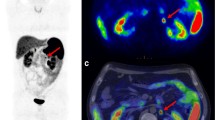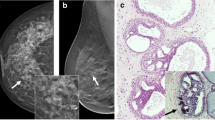Abstract
Purpose
To investigate the clinical significance of enhancing mural nodules ≥ 5 mm by comparing the diagnostic performance of high-risk stigmata for diagnosing the malignant IPMN between the international consensus guideline (ICG) 2012 and 2017 in pancreatic magnetic resonance image (MRI).
Materials and Methods
In this retrospective study, we reviewed preoperative pancreatic MRI with surgically confirmed IPMNs between May 2009 and April 2021. High-risk stigmata, defined by ICG 2012 and ICG 2017, associated with malignant IPMN were evaluated using logistic regression analysis. We calculated and compared the sensitivity and specificity of ICG 2012 and ICG 2017 for diagnosing malignant IPMNs. Receiver-operating characteristic (ROC) curves were used to compare ICG 2012 to ICG 2017.
Results
A total of 73 patients (43 men and 30 women; mean age, 69 years; standard deviation, 8 years) with 34 malignant IPMNs and 39 benign IPMNs were included. Among high-risk stigmata, enhancing mural nodule ≥ 5 mm, and MPD diameter ≥ 10 mm were the significant predictor of malignant IPMN, in multivariate logistic regression (P < 0.001 for all). For the diagnosis of malignant IPMN, the specificity of ICG 2017 for enhancing mural nodules ≥ 5 mm as the high-risk stigmata was significantly higher than that of ICG 2012 (87.2% vs. 64.1%, P = 0.008). However, there was no significant difference in sensitivity between the two guidelines (94.1% vs. 97.1%, P = 1.0). The comparison of the ROC curves showed that the diagnostic performance of ICG 2017 for malignant IPMNs (AUC, 0.91) significantly improved when compared to that of ICG 2012 (AUC, 0.81) (P = 0.01).
Conclusion
When applying enhancing mural nodule ≥ 5 mm as a high-risk stigmata, ICG 2017 provided a significantly higher specificity than ICG 2012 without a reduction in sensitivity.





Similar content being viewed by others
Abbreviations
- ICG:
-
International consensus guidelines
- IPMN:
-
Intraductal papillary mucinous neoplasm
- MRI:
-
Magnetic resonance image
- ROC:
-
Receiver-operating characteristic
- MPD:
-
Main pancreatic duct
- AUC:
-
Area under the ROC curve
- EUS:
-
Endoscopic ultrasonography
References
Aronsson L, Andersson B, Andersson R, Tingstedt B, Bratlie SO, Ansari D. Intraductal papillary mucinous neoplasms of the pancreas: a nationwide registry-based study. Scand J Surg. 2018;107(4):302–7.
Tanaka M, Fernandez-Del Castillo C, Kamisawa T, Jang JY, Levy P, Ohtsuka T, et al. Revisions of international consensus Fukuoka guidelines for the management of IPMN of the pancreas. Pancreatology. 2017;17(5):738–53.
Tanaka M, Fernandez-del Castillo C, Adsay V, Chari S, Falconi M, Jang JY, et al. International consensus guidelines 2012 for the management of IPMN and MCN of the pancreas. Pancreatology. 2012;12(3):183–97.
Watanabe Y, Nishihara K, Niina Y, Abe Y, Amaike T, Kibe S, et al. Validity of the management strategy for intraductal papillary mucinous neoplasm advocated by the international consensus guidelines 2012: a retrospective review. Surg Today. 2016;46(9):1045–52.
Yamada S, Fujii T, Murotani K, Kanda M, Sugimoto H, Nakayama G, et al. Comparison of the international consensus guidelines for predicting malignancy in intraductal papillary mucinous neoplasms. Surgery. 2016;159(3):878–84.
Kim KW, Park SH, Pyo J, Yoon SH, Byun JH, Lee MG, et al. Imaging features to distinguish malignant and benign branch-duct type intraductal papillary mucinous neoplasms of the pancreas: a meta-analysis. Ann Surg. 2014;259(1):72–81.
Seo N, Byun JH, Kim JH, Kim HJ, Lee SS, Song KB, et al. Validation of the 2012 international consensus guidelines using computed tomography and magnetic resonance imaging: branch duct and main duct intraductal papillary mucinous neoplasms of the pancreas. Ann Surg. 2016;263(3):557–64.
Lee JE, Choi SY, Min JH, Yi BH, Lee MH, Kim SS, et al. Determining malignant potential of intraductal papillary mucinous neoplasm of the pancreas: CT versus MRI by using revised 2017 international consensus guidelines. Radiology. 2019;293(1):134–43.
Min JH, Kim YK, Kim SK, Kim H, Ahn S. Intraductal papillary mucinous neoplasm of the pancreas: diagnostic performance of the 2017 international consensus guidelines using CT and MRI. Eur Radiol. 2021;31(7):4774–84.
Hirono S, Tani M, Kawai M, Okada K, Miyazawa M, Shimizu A, et al. The carcinoembryonic antigen level in pancreatic juice and mural nodule size are predictors of malignancy for branch duct type intraductal papillary mucinous neoplasms of the pancreas. Ann Surg. 2012;255(3):517–22.
Trede M, Schwall G. The complications of pancreatectomy. Ann Surg. 1988;207(1):39–47.
Malleo G, Pulvirenti A, Marchegiani G, Butturini G, Salvia R, Bassi C. Diagnosis and management of postoperative pancreatic fistula. Langenbecks Arch Surg. 2014;399(7):801–10.
Raman SP, Horton KM, Cameron JL, Fishman EK. CT after pancreaticoduodenectomy: spectrum of normal findings and complications. AJR Am J Roentgenol. 2013;201(1):2–13.
Lermite E, Sommacale D, Piardi T, Arnaud JP, Sauvanet A, Dejong CH, et al. Complications after pancreatic resection: diagnosis, prevention and management. Clin Res Hepatol Gastroenterol. 2013;37(3):230–9.
Mortele KJ, Lemmerling M, de Hemptinne B, De Vos M, De Bock G, Kunnen M. Postoperative findings following the Whipple procedure: determination of prevalence and morphologic abdominal CT features. Eur Radiol. 2000;10(1):123–8.
Kang JS, Jang JY, Kang MJ, Kim E, Jung W, Chang J, et al. Endocrine function impairment after distal pancreatectomy: incidence and related factors. World J Surg. 2016;40(2):440–6.
Shirakawa S, Matsumoto I, Toyama H, Shinzeki M, Ajiki T, Fukumoto T, et al. Pancreatic volumetric assessment as a predictor of new-onset diabetes following distal pancreatectomy. J Gastrointest Surg. 2012;16(12):2212–9.
Hirono S, Shimizu Y, Ohtsuka T, Kin T, Hara K, Kanno A, et al. Recurrence patterns after surgical resection of intraductal papillary mucinous neoplasm (IPMN) of the pancreas; a multicenter, retrospective study of 1074 IPMN patients by the Japan Pancreas Society. J Gastroenterol. 2020;55(1):86–99.
Tanaka M. Intraductal papillary mucinous neoplasm of the pancreas as the main focus for early detection of pancreatic adenocarcinoma. Pancreas. 2018;47(5):544–50.
Acknowledgements
Nothing to disclose.
Funding
Nothing to disclose.
Author information
Authors and Affiliations
Contributions
SB Hong and NK Lee contributed to the study concept and design. SB Hong, HI Seo, and S Kim acquired the data. SB Hong, and NK Lee analyzed and interpreted the data. SB Hong, and NK Lee drafted the manuscript. NK Lee performed statistical analysis. NK Lee, YM Park, BG Noh, DW Kim, SY Han, and TU Kim made critical revisions to the manuscript. NK Lee supervised the study.
Corresponding author
Ethics declarations
Conflict of interest
We confirm that the manuscript represents valid original work and that neither this manuscript nor one with substantially similar content under our authorship has been published or is being considered for publication elsewhere. The manuscript has been read and approved by all the authors, who are willing to undertake the possible costs of publication. Furthermore, we confirm that there is no conflict of interest (financial or otherwise) that may directly or indirectly influence the content of our submitted manuscript.
Additional information
Publisher's Note
Springer Nature remains neutral with regard to jurisdictional claims in published maps and institutional affiliations.
About this article
Cite this article
Hong, S.B., Lee, N.K., Kim, S. et al. Diagnostic performance of magnetic resonance image for malignant intraductal papillary mucinous neoplasms: the importance of size of enhancing mural nodule within cyst. Jpn J Radiol 40, 1282–1289 (2022). https://doi.org/10.1007/s11604-022-01312-y
Received:
Accepted:
Published:
Issue Date:
DOI: https://doi.org/10.1007/s11604-022-01312-y




